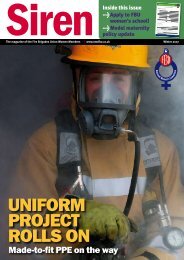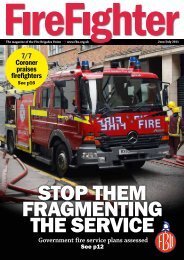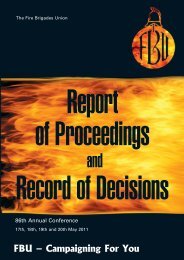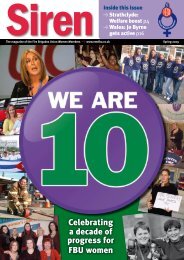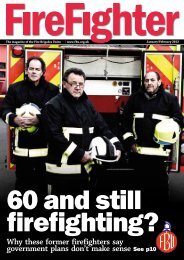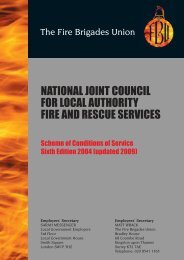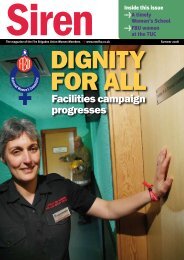Draft London Safety Plan 2010/2013 - Fire Brigades Union London
Draft London Safety Plan 2010/2013 - Fire Brigades Union London
Draft London Safety Plan 2010/2013 - Fire Brigades Union London
You also want an ePaper? Increase the reach of your titles
YUMPU automatically turns print PDFs into web optimized ePapers that Google loves.
this incident was taking place. We are able to estimate<br />
that over the period, there was an average performance<br />
fall of only 1.44 minutes for first appliance attendance and<br />
less than a minute’s delay in the attendance of second<br />
appliances to those incidents that required them.<br />
We get around 60 large incidents a year where 20 or<br />
more fire engines are required during the duration of the<br />
incident, which is why we maintain the numbers of fire<br />
engines available in <strong>London</strong> that we do. We don’t,<br />
however, need all of these vehicles to be instantly<br />
available (large incidents usually develop over a period of<br />
time) so some of them will be allocated work where they<br />
can be recalled to front line duty if or when needed.<br />
Map 3 - where incidents requiring two or more fire<br />
engines happen<br />
RESPONDING TO COMPLEX<br />
BUILDINGS AND STRUCTURES<br />
We know that we can provide a rapid, effective and<br />
sustained emergency response to incidents wherever<br />
they may occur in <strong>London</strong>. We also have a range of<br />
vehicles and equipment to deal with the complexities of<br />
expected and unexpected situations.<br />
But throughout <strong>London</strong>’s design and unique architecture<br />
are a range of buildings and structures that present<br />
distinct challenges to us.<br />
We know from experience that providing more and more<br />
specialised vehicles to meet the challenges of new and<br />
more complex structures isn’t enough to achieve the<br />
safety of those who occupy those buildings, or our<br />
firefighters if they have to attend in an emergency.<br />
So instead we seek to ‘design in’ safety into buildings as<br />
they are built or redeveloped. There are now a range of<br />
building standards and codes which require buildings to<br />
meet fire safety protection standards for their inhabitants<br />
and provide firefighters with improved access, protection<br />
and fire fighting capabilities. <strong>Fire</strong> regulations, which we<br />
enforce, ensure that these facilities within buildings are<br />
maintained and available for use.<br />
Examples of buildings that have significant ‘designed in’<br />
fire safety are high-rise buildings. Our vehicle fleet<br />
currently has 11 aerial (high reach) appliances. These<br />
have a typical maximum working height<br />
of around 30 metres – which is sufficient<br />
reach for around 96 percent of all the<br />
buildings in <strong>London</strong> and more than 80<br />
percent of all of <strong>London</strong>’s high-rise<br />
buildings. Beyond 30 metres the<br />
capabilities of any fire appliance are<br />
greatly reduced. Currently the greatest<br />
reach of any commercially available fire<br />
appliance in the world is around 100<br />
metres. All of <strong>London</strong>’s 10 tallest<br />
buildings are taller than this and when<br />
the ‘Shard’ development is completed at<br />
<strong>London</strong> Bridge it will have a total height<br />
of over 300 metres and an occupied<br />
floor height of 244 metres.<br />
Knowing we could never mount an<br />
external firefighting attack to fires in<br />
these very tall buildings means that we<br />
prepare tactics so that we can fire fight<br />
from within the building itself. Our<br />
firefighters are trained for this and the building design<br />
gives protection to our firefighters and increased<br />
protection to the building occupiers who may have to stay<br />
within the building while the fire is brought under control.<br />
And these building design features aren’t only for very tall<br />
buildings. In <strong>London</strong>, any new building with an occupied<br />
floor height of more than 18 metres will have enhanced,<br />
designed in, fire safety protection and our enforcement of<br />
fire regulations ensures that building owners are held<br />
accountable for maintaining these facilities.<br />
Designed in fire safety applies to more than just high-rise<br />
buildings. We have extensive arrangements in place with<br />
Transport for <strong>London</strong> to protect <strong>London</strong> Underground’s<br />
rail system and we work with building owners,<br />
developers and local boroughs to ensure places where<br />
people live, work or socialise are adequately protected<br />
and provide our firefighters with the protection and<br />
resources they need should an emergency happen.<br />
13





